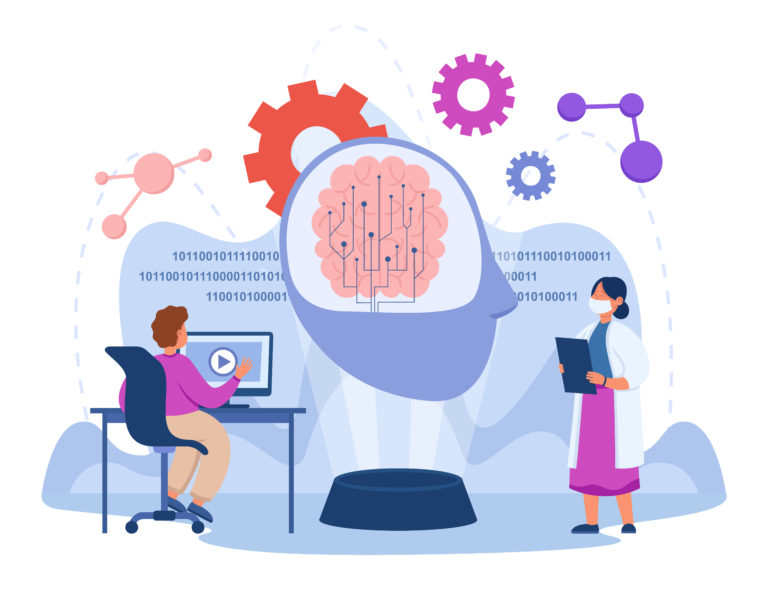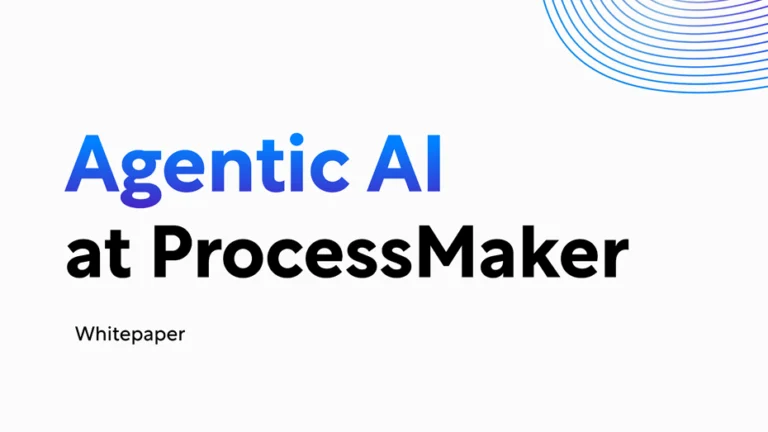Intelligent business automation involves software that uses artificial intelligence (AI) and other technologies to automate repetitive tasks. It uses processes, algorithms, and machine learning to automate tasks that don’t require human judgment or decision-making.
Why do we need these systems?
Humans are flawed. And we have limited time even when we aren’t flawed. Therefore, automation is important to all organizations. However, business automation can be complicated, costly and time-consuming.
To alleviate this complexity, it’s crucial to utilize a framework that combines DPA (Data-driven Process Automation), RPA (Robotic Process Automation) and AI (Artificial Intelligence). This combination allows businesses to automate in ways that were never before possible.
The hype surrounding intelligent business automation
Intelligent business process automation (BPA) is the next evolution of BPM. Here’s why that’s important.
BPM is a way to automate processes, which allows people and companies to be more efficient and effective when getting things done. IBA takes this one step further by leveraging intelligent algorithms that can predict trends and uncover patterns in data to interpret them more accurately than humans could on their own.
This makes it much easier for organizations to decide what steps need to be taken next for their processes to run smoothly without any issues or setbacks along the way. In other words, it helps businesses become savvier about what they do with every new project introduced into their systems.
The hype surrounding intelligent business automation (iBPA) is at an all-time high. But with so many companies jumping on board, it can be challenging to know how to create a successful IBA strategy for your organization. When considering how to incorporate AI into your company’s processes, it is vital that you understand the difference between AI and machine learning (ML). AI is developing computers that can think like humans; ML is writing algorithms that can learn independently.
These two terms are often used interchangeably in the press and industry circles, which often confuses people trying to understand what they mean when they hear someone refer to “intelligence” or “artificial intelligence.” The distinction between these two technologies will help you better understand what type of technology would best suit your business process challenges and goals.
But how do you combine AI with RPA and DPA? After all, they’re all good at specific tasks like automating manual processes or gathering data from various sources. They also have their strengths: RPA excels at process automation and data enrichment; DPA offers intelligent insights into unstructured information; while AI provides a platform for building intelligent applications that can learn over time by making decisions based on large amounts of data and algorithms.
In addition, businesses that want to leverage technology for continuous improvement should consider using these technologies in combination with each other:
- Digital process automation platforms enable you to model and simulate your existing manual processes to create an intelligent simulation of them; this allows you to see where improvements can be made before automating any part of the process.
- RPA enables you to automate manual tasks in your organization by mimicking how people already perform those tasks manually today; this ensures that no additional skill set is required on behalf of employees who may take over the automated task once it’s completed successfully through RPA.
- AI enables cognitive tasks like interpreting data sets, predicting outcomes based on past behaviors/results, or making recommendations based on what the platform knows about customers’ needs and preferences–all things which would otherwise require extensive training time for humans.
Dynamic case management
Dynamic case management mixes case management and BPM, which helps you manage unstructured processes. It’s flexible and agile, ideal for handling exceptions while keeping your business productive.
Dynamic case management has been around since the early 2000s. Still, it’s only recently become more widely used as businesses seek to improve their ability to analyze and adapt quickly. Dynamic case management helps you take the right actions at the right time by defining roles and responsibilities based on data collected in real-time. This means that when an exception occurs within a process or workflow, policy changes can be made on the fly without waiting until next week’s meeting—or even worse—until after something has gone wrong.
Modeling and simulation using intelligent business automation
Modeling and simulation can be used to evaluate the performance of a process or even evaluate a model of your business process.
A smart way to use modeling and simulation is to simulate how your business will run under different conditions. For instance, you could simulate different scenarios for customer service calls or shipping times and then adjust accordingly based on what works best for your company’s needs.
This technique works exceptionally well when combined with other forms of intelligent automation, like machine learning or artificial intelligence (AI).
The intelligent business automation framework is a combination of three key technologies:
- RPA (Robotic Process Automation)
- AI (Artificial Intelligence)
- DPA (Document Process Analytics)
Using these technologies in tandem creates an intelligent business automation system, which allows you to automate repetitive tasks, analyze data and gain insight into your business processes. Leverage machine learning technology to make intelligent recommendations based on the data you’ve collected.
Intelligent case management
Intelligent case routing uses AI to route cases to the right person or queue based on their processing priorities. This can be done in two ways:
- AI is used to identify high-priority cases that need processing by a human operator as soon as possible and then automatically assign them to least busy employees (e.g., after lunch).
- AI is used first to route all incoming emails into separate inboxes according to their priority level (e.g., Priority 1: Urgent; Priority 2: High; Priority 3: Low) and then assign them automatically depending on each employee’s workload load (e.g., if you’re already working on four high priority tasks and have no time left for anything else).
IBA for sales and product recommendations
Sales and product recommendations based on behavioral analytics can provide a great way to improve your business revenues.
Suppose you want to deliver more personalized products that cater specifically to each customer. In that case, using behavioral analytics can help since it facilitates more accurate product recommendations that are more tailored toward each client’s specific needs.
Customer sentiment analysis and subsequent best action recommendations
Another use case is customer sentiment analysis and following best action recommendations. Knowing how your customers feel about your product or service can help you improve it, so businesses often look to their data for insights into what customers like and don’t like.
Humans or machines can perform customer sentiment analysis. A human will manually read through reviews, check for specific keywords that imply positive or negative sentiment, and then assign a score based on their findings.
However, this method is time-consuming and only analyzes a limited amount of data at once—it’s hard to get an accurate picture of the overall tone from such small sample sizes. By contrast, machine learning algorithms can analyze large amounts of data to gauge the style of texts without requiring human intervention (and without being biased).
Intelligent business automation is the key to predictive and adaptive analytics
Intelligent business automation is the application of intelligent technologies to the entire process of running a business. It helps automate repetitive tasks and human decision-making processes.
Predictive analytics uses data to forecast what will happen in the future. In contrast, adaptive analytics uses data to learn from past mistakes and improve future decisions.
Predictive analytics has also proven its effectiveness in many industries, including finance, retail, health care, and manufacturing. It’s been used by companies like Apple, Amazon, and Netflix to boost their sales and customer satisfaction rates.
Adaptive analytics is also becoming more common among businesses today. They seek new ways to improve their operations and increase profits. For example:
Adaptive marketing. Using algorithms that analyze users’ preferences, companies can predict what product or service will be most appealing to each customer based on past purchases or searches online; then, they can send out targeted ads based on this information so that customers feel like they’re receiving personalized messages from those companies instead of generic ones that don’t seem targeted enough for them (like when you get an ad for something you’ve never bought before).
The voice of the customer (VOC) insights for CSAT improvement
The voice of the customer (VOC) is a powerful tool for improving customer satisfaction and loyalty. It can identify areas of improvement, highlight opportunities for process improvements, and improve overall CSAT scores.
When optimizing your customer experience, you can’t afford to overlook VOC data. Using machine learning and predictive analytics to analyze VOC data, you can build a foundation for continual improvement across all online or offline channels.
You can use this information in real-time or over time to identify trends in customer sentiment; make adjustments so that your next interaction with a customer goes more smoothly; increase sales by focusing on happy customers rather than those who have expressed dissatisfaction; generate suggestions on how best to anticipate their needs.
Plug-in APIs
If you’re searching for a way to integrate RPA or ML/AI solutions with your business, one of the first things you should do is look into APIs. Many vendors offer APIs that can be used to plug into their products and others’ products. Additionally, most vendors offer APIs which enable data transfer between their platform and other systems like Box or Google Docs.
BPM Automation is appropriate for end-to-end process orchestration to scale complex business processes
BPM automation integrates and coordinates all elements required to execute a process, including data inputs, activities, and outputs.
AI is the technology that can power the ability for companies to deliver smarter customer experiences, improve business processes, and drive growth. It’s an enabler for digital transformation.
If you think about it this way—that AI is something that runs in the background and can be used to bring together a wide range of digital transformation projects—you’ll see how combining these tools can lead not only to better results but also faster delivery times because it reduces time spent waiting on handoffs between teams working on separate parts of a project (e.g., an RPA team handing off work to a data scientist).
Use intelligent business automation to improve your processes intelligently
Intelligent business automation can be used to improve processes in a variety of ways. For one, you can use it to automate tasks, thus freeing up resources and allowing us to focus our energies elsewhere. It also improves the quality of data we receive from external sources by giving us insight into what data is reliable and which is not.
Finally, the machine learning aspect enables intelligent automation – where business processes are “smart” enough that they know how best to perform their tasks without human intervention or oversight.
To increase success in today’s digital world, organizations need to automate their business processes and use intelligence to drive outcomes.





